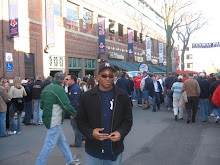
For the last year and a half, this argument has been the topic of hour’s long discussion on talk radio shows and message boards. Sometimes, this bleeds its way into the broadcast.
It is unavoidable.
Should Joba Chamberlain be better served to the Yankees as a starting pitcher, or as Mariano Rivera's top setup man?
Points and counterpoints have made on each side, pleading its case as to why one or the other should happen. They will list statistical evidence as to why this should be the case and state that a pitcher who give you between 170 and over 200 innings is invariably better than a pitcher who is only giving you likely no more than 80 innings for the season.
The counter to the argument is that while Chamberlain may not pitch as many innings, the fact he can come into 80 games and slam the door in the 8th inning leading up to Rivera is much more impact than the 25 to 30 starts he would give you and likely not complete anyway due to the advent of innings limits and pitch counts.
So this was the conundrum facing the Yankees.
Do they allow this talent to try and develop into their own version of Josh Beckett? Or, do they pair him with Mariano Rivera to give them a devastating 8th-9th inning combination?
Smartly, the Yankees decided on the route of the starter.
Very good starting pitchers are difficult to find in a normal sense. Finding ace pitchers are nearly impossible unless you are drafting high, get lucky, or in some cases, spending $161 million to acquire it. Few teams have that kind of coin lying under a mattress.
So when you have a pitcher such as Chamberlain, who was drafted and developed as a starting pitcher before the middle of the 2007 season when he was converted to reliever out of necessity, you need to give him every chance to see if he can succeed in that role before considering any other option.

Last year, the Yankees stupidly tried to convert him during the season, foolishly using the regular season as an extended spring training to build up with stamina. He would start 12 games, pitch to an ERA of 2.76 and looking to developing tremendously before succumbing to a shoulder injury in a start in Texas in August and he missed five weeks.
This year, there would be no such drama. However, the question of what do with him bubbled up again when the team signed free agents CC Sabathia and AJ Burnett, resigned Andy Pettitte and had Chien-Ming Wang return from a season ending injury. Having four quality starters is more than what some teams can put out there, and thus could have allowed the Yankees to be flexible considering their depth.
Instead, the organization chose the starter route from Day 1, giving Chamberlain ample time to prepare himself for him role in 2009. He will be on an innings limit of around 150, with flexibility in the event of postseason play.
Back to the debate, it would seem to be an open-shut case as far as a starter over reliever, but even I took a while to convert over to this side of argument several years ago.
When you watch baseball, you are more apt to see the end and fixate in your mind that as opposed to the totality of the game that night. If the bullpen comes into the game in the 6th or 7th inning and blows the game, the fact that the starting pitcher was not effective enough to go deep into the game should also be looked at as to how important of a commodity having a premium, top-level starter truly is.
If have a pitcher the likes of Johan Santana, Roy Halladay, Josh Beckett and CC Sabathia, on most nights you can assure yourself of getting the 7 innings needed to save your bullpen. My theory has always been "the less relief pitchers I see, the better".
The Yankees are banking on Chamberlain to be one of "those guys" if not next year, but in future seasons. This is not a "2009 project", but it is long range vision.
For the only issue now is whether pitching this large bulk of innings will lead to injury. Many teams passed on him in the 2006 amateur draft because of such concerns despite his high level of talent (otherwise he would have been gone before the 44th pick and not Ian Kennedy, who was taken 17th). His shoulder injury he suffered last year only added to those worries.
In spring training, the velocity on his fastball has been clocked between 88-92 MPH. This is a far cry from the 96 to 98 that we are accustomed to seeing him at. Perhaps this is a sign of him needing to pace him for fear of injury, knowing that now he is going to be required to pitch 90 to 110 pitches a start, he cannot treat pitching as if this were football and attempt to strike everyone out.
But does some of his effectiveness get taken away if has to pace himself? No one knows the answer to this question until the season starts and he gets on the mound. It will be just one of those subplots to track through this season.
"The Joba Story"

No comments:
Post a Comment